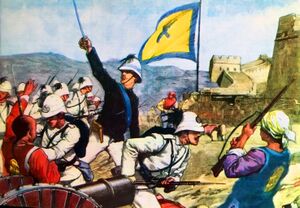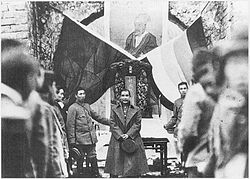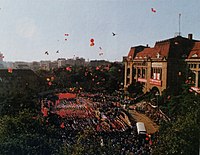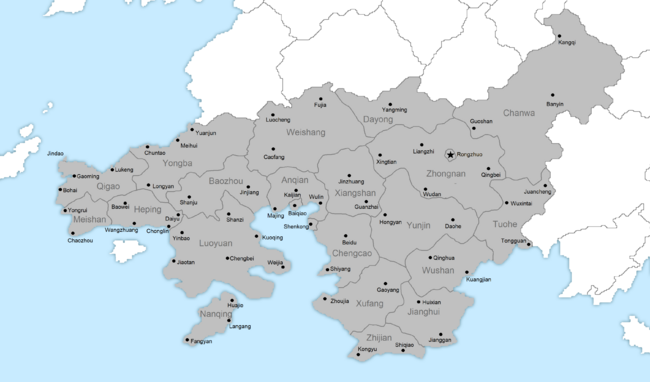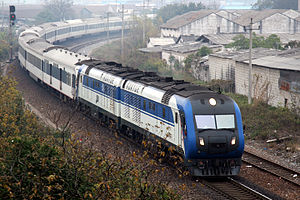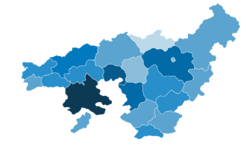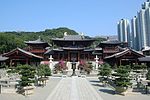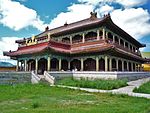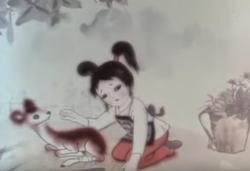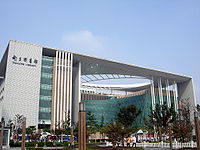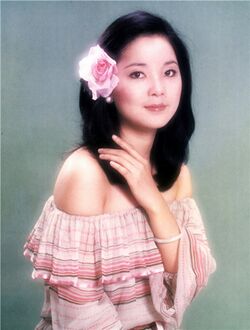Shangea: Difference between revisions
Britbong64 (talk | contribs) |
Britbong64 (talk | contribs) |
||
| Line 205: | Line 205: | ||
The new government was beholden both to the army and the {{wp|far-right}}, being {{wp|militarism|militarist}}, {{wp|monarchism|monarchist}} and {{Wp|expansionism|expansionist}} in its outlook. The Shanrong Emperor purged Zhao from the regime in 1922 removing the largest ''de facto'' check on his power and asserting his personal power. Anti-Senrian and {{wp|racial supremacy|racial supremacist}} rhetoric was commonly deployed. The new regime deeply admired the national functionalist regime in Gaullica and deepened cooperation with Gaullica, joining the [[Entente]] in 1922 as its fourth member alongside Gaullica, [[Poliania]] and [[Marirana]]. The new regime also supported the Senrian monarchist government during the [[Senrian Revolution]] and following the victory of the Senrian republicans began preparations for an invasion of the archipelago to include it into the "Greater Xiaodongese Order". | The new government was beholden both to the army and the {{wp|far-right}}, being {{wp|militarism|militarist}}, {{wp|monarchism|monarchist}} and {{Wp|expansionism|expansionist}} in its outlook. The Shanrong Emperor purged Zhao from the regime in 1922 removing the largest ''de facto'' check on his power and asserting his personal power. Anti-Senrian and {{wp|racial supremacy|racial supremacist}} rhetoric was commonly deployed. The new regime deeply admired the national functionalist regime in Gaullica and deepened cooperation with Gaullica, joining the [[Entente]] in 1922 as its fourth member alongside Gaullica, [[Poliania]] and [[Marirana]]. The new regime also supported the Senrian monarchist government during the [[Senrian Revolution]] and following the victory of the Senrian republicans began preparations for an invasion of the archipelago to include it into the "Greater Xiaodongese Order". | ||
In January 1927 Senrian occupied the Xiaodongese concession of Sakata. After delivering an ultimatum that was rejected by Senria on the 2 February Xiaodong launched an invasion of Senria triggering a set of alliances that started the [[Great War (Kylaris)|Great War]] which pitted the Entente against the [[Grand Alliance]] which included Senria, [[Estmere]], [[Werania]] and [[Narozalica]]. Xiaodong would make large advances into Senria creating a [[Reformed Government of Senria|client state]] based in the north as well as into [[Satria]] benefiting from fighting predominantly poorly armed forces. Xiaodongese advances continued until 1931 when they would largely become bogged down in stalemates or lose ground to Grand Alliance forces, particularly in Senria. | |||
[[File:奉系軍閥的FT-17.jpg|thumb|250px|left|Xiaodongese troops entering Sakata during the [[Great War (Kylaris)|Great War]]]] | [[File:奉系軍閥的FT-17.jpg|thumb|250px|left|Xiaodongese troops entering Sakata during the [[Great War (Kylaris)|Great War]]]] | ||
During their occupation of Senria Xiaodong would be responsible for what would become known as the [[Senrian genocide]]. In Xiaodongese-occupied territories in Senria it is estimated about 9.5 million Senrians were killed by Xiaodongese occupying forces, either through murder, starvation or disease. The genocide was as a result of Xiaodongese attempts to destroy the Senrian population due to supremacist ideology. It remains the biggest genocide in human history. | During their occupation of Senria Xiaodong would be responsible for what would become known as the [[Senrian genocide]]. In Xiaodongese-occupied territories in Senria it is estimated about 9.5 million Senrians were killed by Xiaodongese occupying forces, either through murder, starvation or disease. The genocide was as a result of Xiaodongese attempts to destroy the Senrian population due to supremacist ideology. It remains the biggest genocide in human history. | ||
Revision as of 10:50, 16 June 2020
This article is incomplete because it is pending further input from participants, or it is a work-in-progress by one author. Please comment on this article's talk page to share your input, comments and questions. Note: To contribute to this article, you may need to seek help from the author(s) of this page. |
Auspicious Republic of Xiaodong 晓东吉祥共和国 Xiǎodōng Jíxiáng Gònghéguó | |
|---|---|
| Motto: 吉祥我国多么光芒万丈! How bright is our Auspicious Nation! National ideology: National Principlism | |
| Anthem: 保卫我们伟大的祖国 Bǎowèi wǒmen wěidà de zǔguó | |
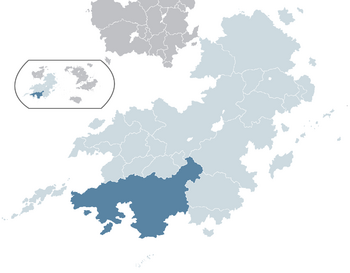 Location of Xiaodong in Coius | |
| Capital and largest city | Rongzhuo |
| Official languages | Xiaodongese |
| Other | Chanwan, Ba, Shukin, Hohua, Dakatan |
| Ethnic groups (2013) | Xiaodongese (57.4%) Chanwan (13.2%) Other (29.4%) |
| Demonym(s) | Xiaodongese |
| Government | Unitary authoritarian republic |
| Yuan Xiannian | |
• Premier | Xi Yao-tong |
| Yuan Qinqin | |
| Wang Hongzhi | |
| Legislature | State Presidium |
| Establishment | |
| 1866 | |
| 20 September 1936 | |
| Population | |
• 2018 estimate | 553,746,000 |
• 2013 census | 545,462,000 |
| GDP (PPP) | estimate |
• Total | $9,709,936 million |
• Per capita | $17,535 |
| GDP (nominal) | estimate |
• Total | $5,301,564 million |
• Per capita | $9,574 |
| Gini | 36.8 medium |
| HDI | 0.744 high |
| Currency | Renjin (RJN) |
| Date format | yyy-mm-dd |
| Driving side | right |
| Calling code | +893 |
| ISO 3166 code | XI |
| Internet TLD | .xi |
The Auspicious Republic of Xiaodong (晓东国吉祥共和国; Xiǎodōngguó Jíxiáng Gònghéguó) more commonly known as Xiaodong (晓东国; Xiǎodōngguó) is a nation in Coius bordering Tinza to the east, the unrecognised republic of Heijiang to the southeast, Zorasan and Kumuso to the north, Phula, Dakata and Baekjeong to the northwest and in the west having maritime borders with Senria. It has a population of 545,462,000 with a nominal GDP of $5,301,564 million, with its capital and largest city being Rongzhuo located in the northeastern interior.
The home of the Xiaodongese people, Xiaodong was first united by the Jianzhao Emperor in 200 BEC under the Xiang dynasty which ruled Xiaodong from 200 BCE to its collapse in 500 CE - during the rule of the Xiang dynasty Confucianism and Taoism became prevalent. Following the Xiang for 100 years Xiaodong was politically unstable in the period known as the "War of Four Kingdoms" as rival warlords and nobles fought for control. In 731 Xiaodong was united again under the Tao dynasty that introduced Buddhism and Kamism whilst overseeing the high point of Xiaodongese literature and art. However, in 1415 the Tao dynasty was usurped by the Jiao clan who created the Jiao dynasty, which fused Buddhism, Taoism and Confucianism together to create Taojiao. Although initially wealthy, by the 1600's the Jiao dynasty was being torn apart by civil war and uprisings, most disastrously the Red Orchid Rebellion in 1656. In 1680 the dynasty finally collapsed, resulting in a Senrian warlord to conquer Xiaodong and create the Toki dynasty. However, the Toki's attempts to promote Senrian culture led to the development of Xiaodongese nationalism. During the late 1700’s and early 1800’s the Toki came under pressure from various colonial powers, losing suzerainty over Damat and having to lease several port cities to countries such as Gaullica, Estmere and Etruria. A default of Xiaodongese debts in 1847 led to foreign domination of the Xiaodongese economy which started to cause substantial unrest. The continued failure to confront foreign powers led to a coalition of nobles and military officers in 1876 to stage the Baiqaio Revolution with overthrew the Toki dynasty and led to the enthronement of the Xiyong Emperor who created the Heavenly Xiaodongese Empire (a semi-constitutional monarchy) and oversaw a period of economic modernisation and semi-constitutional rule. Between 1875-1888 Xiaodong subjugated neighbouring states and attempted to renegotiate many of the unequal treaties imposed on Xiaodong, becoming a great power in the process. In 1911 Xiaodong underwent the Constitutional Revolution which led to the creation the first Xiaodongese constitutional revolution.
During the 1920's the Xiaodongese state became more totalitarian which heightened under the Zhanxun Emperor who formulated an alliance with Gaullica. Xiaodong launched an invasion of Senria in 1927 which led to the start of the Senrian-Xiaodongese War which was soon absorbed into the Great War which saw Xiaodong defeated by the forces of the Grand Alliance. The end of the Great War led to the overthrow of the monarchy and the creation of the Republic of Xiaodong. The republic was unpopular and soon destablised, leading to the Xiaodongese Civil War. These military failures led to in 1936 the Xiaodongese government to be overthrown in the Corrective Revolution by a group of young military officers who created the Auspicious Republic of Xiaodong, a spiritualist dictatorship under the rule of a coalition of nationalist organisations, chief amongst them the Xiaodong Regeneration Society headed by Lu Keqian who enacted many far reaching political, economic and social reforms. In 1984 Xiaodong began to marketise its economy, although the governing regime has maintained a monopoly on political power. This political hegemony was challenged in 2016 after sustained pro-democratic protests leading to the beginning of "Normalisation under Yuan Xiannian.
Xiaodong is currently a dictatorship, with its ceremonial head of state being Chairperson of the legislative branch of the government, the State Presidium, and the head of government being the Premier of the executive branch of government, the Council of Ministers. Since the 1980's Xiaodong has undertaken substantial political reforms although corruption has remained.
Xiaodong’s economy has been described as being in a system of state capitalism in which bureaucrats and corporations known as Caihongs are the cornerstones of the economy. Although part of the Xiaodongese economy are state owned, it has undergone substantial neoliberalisation with most state owned corporations being privatised. Major Xiaodongese exports include coal, rice, bauxite and coffee. Xiaodong is a member of the Community of Nations, and maintains relations with most other nations, both democratic and dictatorial, having especially close relations with Union of Zorasani Irfanic Republics as part of the Rongzhuo Strategic Protocol Organisation (容㒂戰略议定书组织). Xiaodong's cultural influence, growing economy, interventionist foreign policy and possession of nuclear weapons makes it a great power on the world stage and a regional power in southern Coius, albeit one marked with rivalry with Senria.
Etymology
The name "Xiaodong" derives from the Xiaodongese pronunciation of the characters that make up Xiaodong's name, 晓东. Its name in fuhao is Xiǎodōng (/ɕiɑu tʊŋ/). The characters of 晓东 translate to "Dawning East". The characters were first used to describe Xiaodong by the Tao dynasty, and were during the Toki Sougunate recognised as the name of the country by Xiaodongese nationalists, and was adopted as the name of the country following the Baiqiao Revolution. It is sometimes transliterated in the Latin alphabet as "Shiaodong".
The current name of Xiaodong, the "Auspicious Republic of Xiaodong" (晓东吉祥共和国; Xiǎodōng Jíxiáng Gònghéguó) was adopted following the Corrective Revolution in 1936.
History
Ancient Xiaodong
Xiang dynasty (650BCE-100CE)
The first unified Xiaodongese state was formed around 500 BCE by the legendary Jianzhao Emperor, who created the Empire of Great Xiang (大向帝国; Dà Xiàng Dì Guó). Traditional Xiaodongese canon states that the Jianzhao Emperor was the son of Heaven who successfully united petty kingdoms which he named the "tianxia" (天下; "under heaven"). The existence of the Jianzhao Emperor has been hard to verify with most archaeologists saying the founding of the Xiang dynasty as traditionally told is a myth, with some archaeologists saying that Xiang dynasty was more likely to be founded in 400 BCE. It is known that at the same time of the Xiang dynasty's existence several other smaller kingdoms and that the Xiang emperors retroactively justified the rise of the Xiang as they had taken the "Mandate of Heaven" (天命). The original capital of the Xiang dynasty was recorded to be Fuzhou (复州; Fùzhōu) which is near modern day city of Lunkeng.
Under the Xiang a feudal system was implemented, with the well-field system (井田制度; jǐngtián zhìdù) being its central feature. Society was divided between aristocratic clans that supported a centralised government around the Emperor. The mid-Xiang period (50 BCE - 300 CE) saw a tight centralisation of power by Xiaodongese Emperors, who moved the capital to Rongzhuo (容㒂; Róngzhuó) around 0 CE.
Sun dynasty (100-400)
- Empire of Great Sun - 大孫帝国 - Dà Sūn Dì Guó
- Peasants found this dynasty
- cultural stuff
- dissolves into civil war by 400
Four Kingdoms (400-691)
- four clans continually rule
- division and civil war
- glorious emperor unites Xiaodong
Tao dynasty (691-1356)
- Empire of Great Tao - 大陶帝国 - Dà Táo Dì Guó
- longest serving dynasty
- ruled by strong emperors inspired by legalism
- glorious defeat of Senria by legalist emperor
- buddhism and Kamism arrives
- lots of art and culture
- dynasty gets poor
- weak boy emperor is couped by one family who are the power behind the throne - the Jiao family
Jiao dynasty (1356-1667)
- Empire of Great Jiao - 大皎帝国 - Dà Jiǎo Dì Guó
- clan head becomes emperor
- Jiao are decadent people who squander Xiaodong's riches
- creates Taojiao - mix of Buddhism and confucianism
- almost wins war with Senria before a peasant uprising ruins everything
- oh shit Christianity's arrived, starts repressing it
- goes into decline
Toki dynasty (1667-1868)
- Toki dynasty - 大土岐帝国 幕府时代 (Dà Tǔqí Dì Guó)
- Senrian mercenary takes over
- implements Senrian like government system
- hated by most Xiaodongese
- Loss of wars to Euclean powers, unequal treaties
- overthrown, but develops Xiaodongese nationalism as a result of existing
- from a neutral perspective quite good rulers overseeing technological development and a capitalist economy
Heavenly Empire (1864-1935)

The overthrow of the Toki dynasty saw the country officially renamed the Heavenly Xiaodongese Empire (大天晓东帝国; Dà Tiān Xiǎodōng Dìguó) although it was informally referred to as the Yao dynasty. The newly enthroned Xiyong Emperor, although a nationalist, was also a moderniser who believed the only way Xiaodong would resist colonisation by Euclean nations was by adapting their economic and military models into Xiaodong. This led to the start of the Great Cultural Rectification Movement (大文化整风运动; Dà wénhuà zhěngfēng yùndòng) commonly known as the "Zhengfeng" (Rectification) which aimed to rapidly modernise and industrialise Xiaodong. The first phase was military modernisation; almost as soon as the Empire was declared the provincial militaries were abolished and merged into a single standing army, the Heavenly Army of Xiaodong. New arsenals were created being handled directly by the central government rather then provincial authorities, creating new modern arms mainly copying Gaullican designs.
The success of military modernisation led to the second phase of reforms in the economy and the agriculture in particular designed to permanently curb the power of rural landlords and provincial nobles to the benefit of the central government. Under the direction of Rao Qiaonian and Gaullican banker Jérôme André Murat a central bank was created, unused land held by noble families that supported the Toki were placed under government control, provincial tax systems were harmonised and large industrial conglomerates with government support named Caihongs (财行; Cáiháng) were created to facilitate industrialisation. The most impressive of these measures was a huge investment in creating a Baiqiao to Rongzhuo railway. Education reform was also undertaken placing more emphasis on mathematics and sciences over classical texts whilst the University of Baiqiao was created in 1868. Cultural reforms designed to "Xiaoicise" the nation also were implemented - the former imperial language of Senrian was banned, chonmages were forcibly shaved off, the Xiaodongese language underwent greater standardisation by the government intended to stamp out dialects and regional privileges were revoked in favour of central government control. Foreign missionaries were also restricted from preaching, a decision that aroused opposition from Euclean countries but was popular within nationalist circles.
In the effort to secure more Euclean designs and assistance for military and industrial development the Xiyong Emperor endorsed several reforms that allowed for large amounts of foreign investment by Euclean companies - particularly Gaullican ones through its port city of Jindao - to go into the country mainly through the construction of railroads. These moves led to increasing industrialisation and economic growth, although aroused the opposition of conservatives and nationalists in the Grand Council meaning the government often acted cautiously in matters of non-military reforms.
The reforms aroused bitter opposition from conservatives in the court and nobles and led to the xxx Incident, when several army regiments loyal to court conservatives attempted to launch a coup d'état. The coup attempt unsuccessful after a tipoff had allowed the Xiyong Emperor to order several army units to arrest the conspirators leaders and ordering their public execution. As a result of the coup attempt the Emperor promulgated a constitution that created a legislative assembly that gave nobles institutional power. However the newly created post of Imperial Chancellor was appointed by the Emperor with the "arch-reformist" Yao Shusheng becoming the first holder of the post.
The new government undertook a policy of imperialist expansionism. Invasions of neighbouring states like Chanwa, Dakata and Tinza saw annexations of vast swathes of land and a reassertion of the tributary system that had prevailed prior to the early 1800's. The so-called "new tributary system" saw the establishment of a much tighter sphere of influence then had existed previously as Xiaodongese intellectuals mixed traditional notions of cultural superiority with Euclean scientific racism. The new sphere of influence however provided a degree of protection from Euclean imperialism with southern Coius often referred to in Xiaodong as the "Great Xiaodongese Order".
In 1887 a series of disputes surrounding the Etrurian concession of Gaoming saw hostilities break out with both Etruria and Xiaodong declaring war on each other. Lasting a little more then a year and fought mainly on Xiaodongese soil the decisive Battle of Jungfa saw the Etrurian expeditionary force almost wiped out by Xiaodongese troops. The Treaty of XXX saw Etruria forced to renegotiate several unequal treaties with Xiaodong in the latters favour. Whilst not acquiring Gaoming as planned, the defeat of a Euclean power increased the prestige of Xiaodong abroad, with Xiaodong renegotiating several more unequal treaties with other Euclean powers shortly afterwards. By his late reign the Xiyong Emperor's health had started to decline with more power being passed onto the elected assembly, especially after imperial chancellor Kang Qisun passed a series of liberal reforms increasing representation at a local level. In 1906 the emperor died - at his death the Xiaodongese state had begun the path to industrialisation and military dominance in the region although its industrialisation was incredibly lopsided. Outside industrial centres the country remain chronically underdeveloped with many rural areas still resembling medieval times with peasant and industrial unrest being high.
The Xiyong Emperor's son, the Qingzhuo Emperor, largely continued the trend towards industrialisation, constitutionalism and military expansion. In 1909 Xiaodong through gunboat diplomacy acquired its own concession, Sakata, from Senria whilst becoming more nakedly imperialist within its own sphere of influence. The country was wholly unprepared for the Great Collapse in 1913 when demand for its main export industries - rice and silk - plummeted, driving the country to near bankruptcy. The crisis was followed with a large famine in 1914 that swept across southern Xiaodong with up to 11 million people starving as a result.
The economic collapse in 1913 and famine in 1914 unleashed political and social tensions that had simmered under the surface for decades. Radical socialists in the Xiaodongese Section of the Workers' International were successful in calling a series of strikes and armed rebellion in many of the nations cities. In the countryside millennian groups gained in popularity alongside anarchist federations. The far-right also saw an upsurge in popularity especially amongst conscripts in the army. The seeming social breakdown were compounded with the Qingzhuo Emperor's attempts to centralise power around himself and a small clique of advisers, many of whom were seen as incompetent and corrupt. A series of short-lived governments ruled in the time period but the nation was overall seen to be in a "state of anarchy" outside the major cities. Organised crime in the form of the triads also saw an expansion in this time period.

In 1920 an anarchist peasant group, the XXX, launched a revolt in the Baozhou province over rice taxes an event that would come to be known as the "Red Summer". The revolt was large and well organised amongst the peasantry causing the provincial governor Zhao Hongjun to unilaterally deploy the army to crush the rebellion with the Baozhou massacre ending the political power of the radical left. The government's seemingly weak response to the revolt alongside the string of poor government policies and economic and social disruptions meant that Zhao and his supporters were able to persuade the emperor's brother to a successful palace coup known as the Jiayun Uprising that deposed the Qingzhuo Emperor and saw the enthronement of the Shanrong Emperor who abolished the legislative assembly becoming a de jure absolute monarch.
The new government was beholden both to the army and the far-right, being militarist, monarchist and expansionist in its outlook. The Shanrong Emperor purged Zhao from the regime in 1922 removing the largest de facto check on his power and asserting his personal power. Anti-Senrian and racial supremacist rhetoric was commonly deployed. The new regime deeply admired the national functionalist regime in Gaullica and deepened cooperation with Gaullica, joining the Entente in 1922 as its fourth member alongside Gaullica, Poliania and Marirana. The new regime also supported the Senrian monarchist government during the Senrian Revolution and following the victory of the Senrian republicans began preparations for an invasion of the archipelago to include it into the "Greater Xiaodongese Order".
In January 1927 Senrian occupied the Xiaodongese concession of Sakata. After delivering an ultimatum that was rejected by Senria on the 2 February Xiaodong launched an invasion of Senria triggering a set of alliances that started the Great War which pitted the Entente against the Grand Alliance which included Senria, Estmere, Werania and Narozalica. Xiaodong would make large advances into Senria creating a client state based in the north as well as into Satria benefiting from fighting predominantly poorly armed forces. Xiaodongese advances continued until 1931 when they would largely become bogged down in stalemates or lose ground to Grand Alliance forces, particularly in Senria.

During their occupation of Senria Xiaodong would be responsible for what would become known as the Senrian genocide. In Xiaodongese-occupied territories in Senria it is estimated about 9.5 million Senrians were killed by Xiaodongese occupying forces, either through murder, starvation or disease. The genocide was as a result of Xiaodongese attempts to destroy the Senrian population due to supremacist ideology. It remains the biggest genocide in human history.
From 1931 to 1932 Xiaodong rapidly lost territory in Senria being driven out of the archipelago in 1932. Grand Alliance forces following the liberation of Senria began preparations for an invasion of the Xiaodongese mainland with bombing campaigns destroying much of Xiaodong's infrastructure with the Shanrong Emperor being killed in a bombing raid. His successor, the Taiyi Emperor, provided poor leadership during the Senrian invasion of Xiaodong that saw Senria make rapid advances across Xiaodong's northern coast in 1933-1934. By 1935 the Xiaodongese state and military defences were in a state of near collapse as sections of the country attempted to declare independence; however the Grand Alliance was unable to advance as it became clear that any attempt to occupy Xiaodong fully would result in a long and bloody war of attrition even after 8 years of war.
In 1935 the Battle of Baiqiao saw the capital fall to Senrian forces. The fall of the capital led the Taiyi Emperor to abdicate appointing Meng Jianing as regent who ordered the dissolution of the Heavenly Empire declaring its replacement to be the Republic of Xiaodong, ending over 2,000 years of imperial rule. The republic signed the Treaty of Keisi shortly afterwards which saw Xiaodong cede a large amount of territory to newly created countries, ending its tributary system, paying large reparations to Grand Alliance powers, restricting the size of its military and placing many of the senior figures during the war still alive such as former chief of staff Ren Xilian and the Taiyi Emperor on trial for crimes against humanity. The treaty was considered to be deeply humiliating for Xiaodong with the country becoming political unstable following its signing.
Auspicious Republic (1936-present)
- New republic abrogates the Treaty of Keishi causing crisis for CoN. Eventual renegotiation in Xiaodong's favour; not accepted by Senria.
- Industrialisation and modernisation
- "Peaceful development strategy" in the 1950's-1970's which sees Xiaodong as a bulwark against leftism in Coius
- Coastal Crisis in 1970's
- Neoliberalisation in 1980's, Orchid Revolution
- Duljunese War
- "Nationalist development" in the 2000's under Yuan Xiannian, power struggles common.
- 2016 protests against government - brutally crushed, normalisation pursued.
Government and Politics
Xiaodong's political system is outlined in the 1942 constitution which has undergone numerous amendments since. Xiaodong is organised as a non-partisan federation organised on republican lines and containing a mix of presidential and parliamentary principles. Xiaodong is commonly seen as being an authoritarian state.
The highest body of the state is the State Presidium (国家常务委员会) which is led by a State Chairman (主席) who serves as head of state. The State Presidium is the supreme executive and legislative body in Xiaodong, containing its chairman, the leaders of the four councils, the chief of the general staff and potential other members appointed by the State Chairman. The State Presidium appoints most members of the four councils which sits beneath the State Presidium which fulfil the roles of the executive, legislature, judiciary and civil service examination system.
The four subordinate branches to the State Presidium are the Executive Council (行政局) the Legislative Council (立法会) the Judicial Council (司法会) and the Examination Council (考試会). The Executive Council which is led and appointed by a Premier (首席部長) who functions as the head of government serves as a national cabinet of 40 ministries albeit with the State Presidium taking precedence in executive matters. Xiaodong maintains a four tier judiciary, with federal, provincial, prefectureral and municipal courts with the Judicial Council serving as the supreme court being led by a Chief Justice. All judges, civil servants and politicians are picked from the Examination Council which is led by a president and based on the imperial examination. The Legislative Council contains 785 seats with half elected by voters, a quarter representing industrial and economic sectors and a quarter being appointed by the State Presidium. The top leadership roles of state are the State Chairman, Premier, Vice-Premier and President of the Legislative Council with the incumbents being Yuan Xiannian, Xi Yao-tong, Yuan Qinqin and Wang Hongzhi respectively.
Since 1936 Xiaodong has been an authoritarian state. Officially Xiaodong is a non-partisan state with political parties being banned. Nevertheless a variety of political organisations - commonly seen to operate as factions or secret societies - do exist within the State Presidium. The largest of these is the Xiaodong Regeneration Society (晓东再生会) which established the current governmental system after the Corrective Revolution. For much of Xiaodong’s history the Xiaodong Regeneration Society ruled Xiaodong as a de facto one-party state maintaining control over the state apparatus, media and economy resulting in the opposition is weak. Nevertheless other organisations - such as the Association for Promoting Democracy, the Eight Lanterns Association, the Azure Dragon Society, the Righteous Harmony Movement and the Heavenly Gate Society - exist within the state apparatus. Most of these organisation adhere to a nationalist, statist ideology known as National Principlism (国家主体主义) that seeks to uphold a centralised form of authoritarian democracy. Political apathy is high due to government corruption, authoritarianism and a weak opposition. Unlike in most countries, ideological differences are not the main divides in Xiaodongese politics, which is based much more on guanxi networks between politicians. Nevertheless opposition to these secret societies which make up the governing networks of dangwai organisations that tend to promote more democratic governance compared to the governing cliques.
In 2016 after an economic slowdown and several high-profile corruption scandels a series of protests in favour of political reform resulted in the government of Yuan Xiannian and Xi Yao-tong to launch a crackdown on protesters and the declaration of a state of emergency. International observers state this state of emergency, named "Normalisation" (正规化; zhèngguī huà) has turned Xiaodong into a de facto police state.
Government

Officially the main executive body in Xiaodong is the Executive Council led by the Premier. The Executive Council is responsible for the implementation of the constitution and for the exercise of executive powers in implementing the decrees and general policies as outlined by the State Presidium, except for matters directly related to the State Presidium, who has the final say in all matters. The Premier appoints the members of the Executive Council and are themselves handpicked by the State Presidium, requiring no mandate from the legislature. All members of the Executive Council are approved by the Examination Council. The Premier, State Presidium and Examination Council have the authority to dismiss members of the Executive Council who can also be impeached by the Legislative Council.
In practice the strong role the State Presidium has in governing makes them a far more powerful executive body in Xiaodong and therefore constitute the apex of decision making.
Legislature
Judiciary
Xiaodongese law has since 1936 been based on legalist traditions alongside civil law from Teutonia. Previously Xiaodong maintained a strong Confucianist judicial system based on the belief that the maintenance of tradition would be more effective in maintaining social order, but since the rise of Legalist philosophy since the 1930's the law has become more codified. Nevertheless, the rule of law in Xiaodong is subject to the will of the state which is seen as above the law. Xiaodongese law stipulates one is only guilty if they confess their crime, ingraining torture into the legal system.
The highest judicial authority in Xiaodong is the State Presidium which officially delegates responsibility of such authority to the Minister of Justice. The Minister of Justice can advise the State Presidium to convene the Supreme Judicial Yuan to serve as the highest appeal court if the Minister of Justice deems a case to be applicable to the Yuan, although often requests to convene the body are rejected by the Ministry of Justice.
Subdivisions
Xiaodong is divided into 16 prefectures (省), each with their own regional government head by a chief minister (首席部長) with a prefectural presidium located in a prefectual capital. Prefectures are further divided into 113 counties and finally townships, with cities being a series of merged townships forming a municipality rather than a county. There are 22 municipalities.
There are three special autonomous regions in Xiaodong - Duljun, East Thianchin and Darma. Thianchin and Darma were given devolution in 1988 and Dulju 2002. Under devolution, each SAR has its own regional presidium and governor (省长) - although individual prefectures in the SAR's have less autonomy over tax, health, and public services, the SAR's as a whole has devolved power over areas such as environment, public services, transport, agriculture, housing, aspects of law and order and economic development.
The capital, Rongzhuo, is considered its own administrative unit
| # | Prefecture (省) | Administrative centre | Population |
|---|---|---|---|
| 1 | Darma (德沃爾) | Trishuli (新花园) | 10,826,470 |
| 2 | Shenqu (神曲) | Minqin (民勤) | 3,325,400 |
| 3 | Duljun (山国) | Hejintao (和进套) | 15,266,392 |
| 4 | Fenjiazhi (风家值) | Caofang (操放) | 3,245,900 |
| 5 | Chuqian (处钱) | Zhinning (只能宁) | 3,325,400 |
| 6 | Dongtou (懂头) | Ningjin (宁晋) | 5,145,600 |
| 7 | Jiebu (姐不) | Shenkong (神空) | 9,456,300 |
| 8 | Chenghu (珹湖) | Renpou (人剖) | 3,188,800 |
| 9 | Langang (兰港) | Lunkeng (沦坈) | 5,151,200 |
| 10 | Rongzhuo (容㒂) | Rongzhuo (容㒂) | 22,028,482 |
| 11 | Taixin (台新) | Hongbu (红不) | 3,145,600 |
| 12 | Niushangzi (扭伤自) | Yinbaolei (崟堡垒) | 3,565,400 |
| 13 | Xibuguo (西部过) | Kuoqing (阔请) | 10,317,900 |
| 14 | Gaoming (高铭) | Zhonghe (中和) | 5,123,300 |
| 15 | Huayuan (话元) | Baiqiao (白壳) | 12,257,156 |
| 16 | Thianchin (天津) | Heping (和平) | 6,021,700 |
| 17 | Qingbei (清被) | Guoshan (过山) | 4,243,200 |
| 18 | Meifucun (没付村) | Guojing (过境) | 3,334,300 |
| 19 | Qihongtang (其红糖) | Xiagang (下刚) | 5,145,600 |
| 20 | Zhongdong (中东) | Jinjiang (进疆) | 3,245,900 |
Armed forces and intelligence
The armed forces of Xiaodong is known as the Xiaodongese Defence Forces, which is split into an army, navy and airforce. The Xiaodongese Armed Forces currently has around 1,050,750 troops overall (585,500 active, 225,000 in reserve and 240,250 paramilitary groups). The Chairperson of the State Preisidum is the commander-in-chief of the Xiaodongese Armed Forces, which answers to the Council of Ministers via Ministry of Defence and Military Planning (MoDMP). Military affairs are primarily handled by the Joint Defence Council, a forum of military commanders who are subordinate to the MoDMP. The military in Xiaodong have since 1953 not taken a role in politics, as under single-party rule the top ranks in the military were occupied by party officials. Since democratisation the military have been kept subordinate to the civilian government. The coast guard and gendarmerie forces take on military functions - however, they are responsible to the Ministry of Internal Affairs rather than the MoDMP. The main intelligence unit, the Public Security Secretariat (Shujichu), also is officially part of the military structure however they report directly to the Premier's Office. In recent years, there has been a push to merge the Xiaodongese army together into one cohesive joint command - currently there is intense rivalry between the Shujichu and the military divisions under the MoDMP. Xiaodong currently spends 3.9% ($21,325,710,315) of its budget on the military.
The Xiaodongese Defence Forces were preceded by the Heavenly Xiaodongese Army, which was the first modern army in Xiaodong. Following the abolition of the Heavenly Xiaodongese Empire, the former Heavenly Xiaodongese Army was renamed and consolidated into the Xiaodongese Defence Army, which underwent modernisation in the 1930's. In the 1970's the defence forces underwent modernisation and since 2008 have undergone a further stage of modernisation and restructuring to be a more professional, efficient force. Xiaodong has committed to the development of its navy and airforce, which have been substantially modernised and expanded since 2008. The Xiaodongese navy in particular has undergone a transition from a brown water to green-water navy.
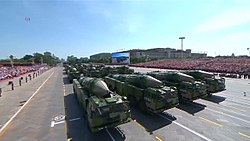
Xiaodong has a history of possessing weapons of mass destruction. During the 1930's it was known that Xiaodong had started to develop a stockpile of chemical weapons in the form of mustard gas, and during the 1950's started a biological warfare research programme. Xiaodong has resisted attempts to sign treaties that ban chemical weapons, and has been accused of possessing chemical and biological weapons such as sarin, nerve and mustard gas - however this has not been proven as of 2015. Xiaodong has admitted that it possess facilities that produce chemical and biological weapons, but asserts that they have been inactive since the mid-1990's. Under Premier Sun Yuting following the Coastal Crisis Xiaodong started to develop a nuclear weapons programme which was mired in development until the mid-2000's (during which Xiaodong maintained strategic ambiguity over possession of nuclear weapons). The first successful nuclear test was conducted in 2008 and since then Xiaodong has expanded its program massively, developing intermediate-range ballistic missiles in 2015. Xiaodong maintains an arsenal of 40-80 nuclear warheads with a sea and land based delivery system. Xiaodong as of 2017 has conducted 5 tests and has a no-first use policy over nuclear weapons.
Conscription - known as "Patriotic Civic Service" (爱国公民勤务; Àiguó gōngmín qínwù) is currently enforced for all citizens between the ages of 18-21 for a period of 24 months. It was introduced in 1869 for all male citizens for a 28 month period with conscientious objection not being recognised by the government, with only those deemed "unfit for service" being exempted. The government mandated that women also be included in conscription in 1938. In 1988 the government reformed the conscription law decreasing the time of service to 24 months and offering alternate service in a non-combatant role on medical grounds, and university students given the opportunity to opt to serve for 12 months in either an combatant or non-combatant role. "Draft evasion" is punished harshly in Xiaodong.
Human Rights
Foreign relations
]Xiaodong's foreign policy objectives since the mid-1940's were formalised in the "Three Fundamentals" - the isolation of Senria from international affairs, the maintenance of Xiaodong as a the foremost great power and the promotion of anti-imperialism in Coius and the Asteria's particularly against Euclean influence. In recent decades Xiaodong has been seen to be revisionist or revanchist in the conduct of its foreign policy albeit this description has been contested by Xiaodongese leaders.
Xiaodong has since the creation of the Auspicious Republic been associated with tensions with its neighbours and its claimed leadership within the developing world. Xiaodong is famous internationally for using "panda diplomacy", using giant pandas as diplomatic gifts to other countries. Panda diplomacy stretches back to the Xiang dynasty when Xiaodong sent pandas to the Senrian emperor as a sign of goodwill. Xiaodong is a member of organisations like the Community of Nations and considered to be the leading power behind the International Forum for Developing States and the Rongzhuo Strategic Protocol Organisation.
Since the foundation of the republic anti-imperialism has been a key feature of Xiaodongese foreign policy. The Rongzhuo Strategic Protocol Organisation or ROSPO was officially founded to "protect Coius from imperialism from Euclea and their client states" (alluding to COMSED) and consists primarily of states that share an anti-imperialist foreign policy such as Zorasan and Ajahadya. Xiaodong also maintains cordial ties with Kumuso and Mabifia in Coius. As part of Xiaodong's "strategic development initiative" it has promoted economic investment in recent years in the Asteria's and Euclea. This has created cordial relations with amongst others Satucin and Piraea.
Xiaodong's strongest bilateral relationship is with Zorasan - whilst the two countries have had differences over water rights, border adjustments and the treatment of religions in the two countries they have worked strongly on economic and military cooperation. This special relationship is known as the Rongzhuo-Zahedan Axis.
Conversely Xiaodong has poor relations with Senria which has traditionally been seen as an ideological, political and economic rival to Xiaodong. Dispute over military forces in southern Coius, economic influence and historical animosity stemming from Xiaodong's view on the Senrian Genocide has created noticeably poor relations with the two countries.
In recent years Xiaodong has come under controversy with its neighbour Tinza following the Tinzan civil war and the creation of Heijiang, a Xiaodongese-supported separatist republic. Xiaodong has been as a result of the creation of Heijiang accused of "freezing" the conflict and embarking on an expansionist foreign policy.
From the 1890's to the 1940's Xiaodong's strongest bilateral relations in Euclea were with Gaullica. However since the 1960's ties with Narozalica have been emphasised. In Euclea Xiaodong has poor relations with Etruria and Estmere, the latter of whom has been unpopular due to its role in the handover of Jindao.
Crime and law enforcement
Geography
Xiaodong's geography is mainly divided between the mountains, hills, plateaus and plains. The northern Duljun is dominated by the Huashan mountain range, with its highest point being located in the Wuxintai prefecture at Mount Shaowei at 2,678 meters. Further south in the Qiaoguo and Liaojing regions the country is dominated by plains and basins. Around 18% of the country is forested, mainly in the central provinces straddling the more mountainous north and the flatter south.
Xiaodong is commonly considered to be a hilly and mountainous country, with only the coastal regions retaining flat land in the form of plains. As a consequence of this, over half the population reside on the coast whilst the more mountainous north remains much more sparsely populated. The south-eastern coast contains the majority of Xiaodong's arable land. Several rivers run through Xiaodong, the longest of which is the Zhuchao River which passes from the city of Henjintao to the southern coast. Several smaller rivers run from the mountainous regions to the coast, with Xiaodong as a result having a well connected water network.
Biodiversity
Climate
Economy
Xiaodong maintains a nominal GDP of $167,318 million, with its average growth rate being 7% since 2000. The main sectors of the Xiaodongese economy are coal, textile, chemical, machinery, iron, and steel.
Xiaodong's economy is driven by a mixture of state owned enterprises (SOE's) and private businesses within the framework of a mixed economy, with SOE's and industrial conglomerates (known as Caihongs) dominating the economy over independent ventures. The close nature between the state and corporations has meant that economists have frequently stated that Xiaodong possesses a corpratist economy, with the state dominating the allocation of capital through indicative planning. This corpratist model which sees both corporate and state bureaucrats being the primary drivers of the economy has resulted in Xiaodongs economy to be called a state-sponsored capitalism. As of 2018 as much of a third of the Xiaodongese economy remains under state ownership, compared to over two-thirds during the 1970's.
Xiaodong is a newly industrialised country with a rapidly expanding industrial sector. The main sectors of Xiaodong's economy is based around heavy industry, mining and agriculture. Bauxite and iron are amongst the most widely mined metals with Xiaodong whilst coal remains the single largest export. Prior to the move to an industrial economy Xiaodong's main export was rice, which continue to be some of the biggest industries within Xiaodong. Since the mid-2000's heavy industry and the production of metals and ships have become two of Xiaodong's largest industries with consumer goods being the largest economic sector.
In 2016 Xiaodong received $98,600 million in foreign direct investment. The government has tried to court more FDI but Normalisation has led to total receipts of FDI to diminish. Xiaodong has $288,428,880,000 in external debt (which is 24% as a percentage of GDP) and $473,504,078,000 in public debt (which is 39.4% as a percentage of GDP).
With a Gini rating of 36.8, wealth inequality remains a serious problem in Xiaodong. According to an independent study conducted in November 2015 over 36% of the nations wealth is concentrated in the top 10% of income earners in comparison to the lowest 10% only receiving 4%. Poverty is also a serious problem in Xiaodong with an estimated 20% of the population living below the international poverty line, and many more working in low paid jobs. The Xiaodongese government has refused to impose a minimum wage, stating it would hurt Xiaodong's competitive nature oversea's, although a recommended "basic wage" exists, albeit unenforced.
Economic history
Following the Corrective Revolution the Xiaodongese government committed to industrialisation and the creation of a modern economy. To achieve massive and rapid industrialisation the state implemented import substitution industrialisation, central planning and the nationalisation of the Caihongs. Over time restrictions on capital flow, foreign investment and financial transactions were implemented as were protectionist policies. The architect of this economic policy was Ma Renzhong who aimed to lead Xiaodong through a "decade of development". During the 1940's-50's economic planning and centralised control was used to industrialise and modernise the Xiaodongese economy - whilst economic growth was achieved by the 1970's this had devolved into high inflation as growth faltered.
Economic failure in the early 1980's led to state officials to abandon import substitution industrialisation and support a form of export-oriented industrialisation. Financial Minister Mao Zhongchen under the direction of neoliberal economist Wang Datong oversaw several shock therapy packages that saw the privatisation of state assets, deregulation especially of the labour market, increased investment into coal as a national resource, the dismantling of tariffs and liberalising other sectors of the economy. Between 1986-2005 Xiaodong maintained a fixed exchange rate with the Luziycan lira until a currency crisis forced Xiaodong to devalue the Renjin. Since then Xiaodong has experienced rising inflation alongside economic growth. In order to lower the price of exports the Xiaodongese government currently follow a policy of forced devaluation of the Renjin keeping its exchange rate (according to critics artificially) low. Alongside the value of the Renjin being kept low interest rates also are held down by the Xiaodongese Reserve Bank. Between 2005-2017 Xiaodong was placed under the New Economic Policy which regulated domestic markets, liberalised the financial sector, utilising economic planning and placing more emphasis on corpratisation rather than privatisation. A stock market crash in 2016 followed by a recession in 2017 has led to further economic reform in Xiaodong with the government committing to market-based structural reform.
Agriculture
Whilst the importance of agriculture has consistently declined in Xiaodong since the move to an industrial economy in the 1940's, it still remains a integral component of the economy. The main corps grown in Xiaodong are rice, soybeans sugarbeets, opium and jasmine tea. Farming in Xiaodong is concentrated in the Fenjiazhi, Chuqianand Zhongdong prefectures, all of which are located in Central Xiaodong.
Xiaodongese agriculture has traditionally been very labour intensive, with the growing of rice and tea traditionally being seen as a cultural tradition. There has been famines in Xiaodongese history although with the development of modern agricultural technology Xiaodong has not suffered a famine since 1855. Since the 1950's most farms in Xiaodong are large scale commercial operations with traditional Xiaodongese farms becoming rarer.
Xiaodong maintains extremely protectionist policies regarding its agricultural industry which is heavily subsidised, with foreign agricultural goods subject to high tariffs. The government has been hesitant to liberalise the agricultural sector out of fear of being a net food importer.
Currency
The official currency of Xiaodong is the Renjin (金). Various forms of the Renjin have existed over the centuries being until 1987 backed by the gold standard. In 1987 the Xiaodongese government under Sun Yuting decreed that the Renjin should no longer be backed by gold, and instead maintain a fixed exchange rate to the Luziycan lira. This was maintained until 2005 when Xiaodong underwent a currency crisis when investors feared that the Xiaodongese government could no longer support the Renjin's exchange rate with foreign capital. As a result of the currency crisis the Xiaodongese government abandoned the fixed exchange rate devaluing the Renjin, which has subsequently been floated by the Xiaodongese Reserve Bank. The Renjin is currently a fiat currency, with one Renjin being worth $0.29 of the universal standard dollar.
Since 2017 the Renjin's value has decreased rapidly with inflation reaching a high of 450% in March 2017 before being reduced to 380% in August. The Xiaodongese Reserve Bank has talked of replacing the Renjin with a new currency to help fight inflation.
The Xiaodongese Reserve Bank is the central bank of Xiaodong and reserves the sole right to issue banknotes and coins. It is run by a Governor who are appointed by the Council of Ministers with advice from the Reserve Banks bored of directors. The Reserve Bank has recently seen its powers curbed - in particular its ability to print money to cover deficits - as part of the government's economic reform strategy.
Energy
The majority of Xiaodongese electricity (70.5%) is generated from coal, with 9.2% coming from natural gas, 8.7% from hydroelectric power, 6.1% from oil and 5.2 from nuclear power. Xiaodongese authorities have in recent years sought to expand the hydroelectric industry at the expense of traditional fossil fuels, although with 85.8% of Xiaodongese electricity being generated by fossil fuels it is still dependent on such sources. The Xiaodongese government expects electricity consumption to increase by an average 3.8-5.1% from 2015-2020.
Xiaodong has one of the largest proven coal reserves in the world, with around 77,833 million tonnes being proven to exist in 2014, with the majority of coal being mined in the Jiebu, Langang, Fenjiazhi, Chuqian, Xibuguo and Zhongdong prefectures with smaller reserves found in the Shenqu and Wuxintai prefectures. A large proportion of Xiaodongese industry is focused on the production and export of Xiaodongese coal reserves - in 2014 it was recorded that 485 million tonnes of coal was mined in Xiaodong. All coal mining in Xiaodong is supervised by the Xiaodongese Mining Confederation.
In 2015 it was recorded that Xiaodong has around 18,500,000,000 m³ of proven natural gas reserves but only 46,500 bbl of proven oil reserves. Both natural resources are under the ownership of the state-owned Xiaodongese Petroleum and Gas, although in recent years the Xiaodongese government has committed to a partial privatisation and allow Zorasani energy companies to extract Xiaodongese gas.
Xiaodong under Sun Yuting during the 1970's actively pursued nuclear energy, constructing four nuclear power stations and pouring billions in nuclear research. However the 1988 Yuxiang nuclear disaster where nuclear waste in a storage tank overheated and exploded with the force of 50 tonnes of TNT releasing 10 MCi of radioactivity led to concerns over Xiaodong's nuclear program, leading to two power stations to be closed down and for the government to invest back into fossil fuels. In 2007 the government under Yuan Xiannian announced massive investments into hydroelectric power with the Jiangshi Dam (one of the largest hydroelectric dams on the plament) being built between 2007-2015.
Industry
Xiaodong has since the 1950's built a sizeable industrial base with the main industries being shipbuilding and metal-products. Xiaodongese industry is overwhelmingly focused towards heavy industry although since the mid-1970's light industry has developed at a fast rate. Since then, Xiaodong's industry is primarily based on the production of iron and steel, as well machinery and shipbuilding. Industry employs around 32.54% of the total workforce.
The fastest growing industrial sector in Xiaodong is the manufacture of machinery and consumer goods, with the development of both being accelerated by recent moves to liberalise the Xiaodongese labour market. The majority of heavy industry in Xiaodong is state-owned by companies such as the Xiaodongese Mining Confederation, the National Bureau for Industrial Development and Rongzhuo Steelworks although in recent years there has been a move to privatise most industry.
Textiles is a growing industrial sector in Xiaodong, especially that relating to silk and wool products. This has followed a general trend for the increased manufacture of consumer goods such as televisions, household appliances and electronic goods. However light industry is still dwarfed by the heavy industrial sector.
Science and Technology
Investment in scientific research has increased in recent years within Xiaodong. Historically Xiaodong has made some scientific advancements especially under the Xiang and Tao dynasties (in particular the development of gun powder and papermaking) but in the 20th century imported a large portion of modern technology. Xiaodongese investment into scientific research increased during the late 1960's and early 1970's when the government created the National Association for Scientific and Technological Research, pairing industrial and scientific institutions and launching a nuclear research committee with the intention of nuclear proliferation. The Nuclear Research Committee was dissolved in 1986 when the government began investing in other scientific research instead. These include the Xiaodongese Space Research Committee, which aims to launch a Xiaodongese man into space by 2050.
Services
The service sector in Xiaodong - which includes banking, finance and tourism - is the fastest growing economic sector in the country, although industry still takes precedence over it.
Xiaodong since the 1980's has sought to rapidly expand its banking and financial services sector first through privatisations and then deregulation. The major domestic banks in Xiaodong (Shenkong Investment Bank, Xiaodongese Bank of Commerce and Zhongdong Industrial Bank) maintain a policy of encouraging customers to buy stocks via loans, with the banks buying stocks back to stimulate further demand. These three banks also heavily invest in government bonds in return for the guarantee of the government investing in and subsequently paying back for key sectors of the economy that banks provide loans for. This model of banking has come under strain since 2016 when a stock crisis caused the banking sector to be nationalised by the government.
Tourism is an increasingly important industry for Xiaodong, receiving 9.7 million tourists in 2016. The industry has developed since the liberalisation of visa controls in the 1960's, with historical Xiaodongese sites and its natural geography being some of the main reasons tourists are attracted to Xiaodong. The majority of tourists in Xiaodong come from surrounding countries such as the Union of Zorasani Irfanic Republics, Damat and Negara. Several countries such as Zorasan and Damat have visa-free access to Xiaodong. A large part of Xiaodongese tourism is domestic tourism, as Xiaodong's expansive public transport system allows for relatively trouble free travel within the country. However Xiaodong is recent years has attempted to attract more international tourists by launching tourism campaigns in Coius, Asteria and Euclea. Most tourists in Xiaodong travel to Rongzhuo, Baiqiao and Henjintao.
With the growth of a consumerist culture retail in Xiaodong is growing at a much faster rate. The largest retail outlets in Xiaodong is Shenzhen Malls and the Silk Market. Xiaodong has come under criticism for poor standards in regards to protection of intellectual property with counterfeit goods commonly on sale in the country.
Transportation
Xiaodong has a developed system of transportation via rail, road, marine shipping and air travel. In recent years the government has invested in its infrastructure to modernise it. Currently Xiaodong maintains several highways and motorways which have been expanded as car travel has become more common. Xiaodong's automobile industry has expanded in recent years as car ownership has increased. Whilst Xiaodong does produce cars domestically they are often lambasted for their poor quality, leading to a large amount of automobiles to be imported from Senria. Bicycles whilst there total use has been declining are still widely used in Xiaodong, with 9% of all trips in the country done via bicycle.
Bus servicing in Xiaodong is deregulated to prefectures and municipalities, with some bus servicing being privatised and others owned by local government. As such bus routes in Xiaodong vary from prefecture to prefecture, with some rural routes being unavailable by bus. Bus servicing in large cities however continue to be a widely used and convenient way to travel.
Xiaodong has a total of 58 airports, with 10 of those being international airports. The largest international airport in Xiaodong is the Lu Keqian International Airport, located in Rongzhuo. Other major airports include Baiqiao Nanbian, Xiyong International Shenkong Airport, Sun Yuting Aiport Kuoqing and Henjintao-Tongguan. The main airline in Xiaodong is Xiaodongese State Airways, a nationalised airline that caters for both domestic and international flights. There are however several smaller private airlines that operate in Xiaodong.
Rail transport is well developed in Xiaodong, with major cities and other urban centres including those in neighbouring countries being connected by rail. The majority of rail services provided by the government-owned Xiaodongese State Railways who divide their services into regional rail, inter-city rail, and rapid transit. Some high-speed lines are operated by a compendium of private train companies as are some international lines. Railways are some of the most used transport in Xiaodong with an average 380 million passengers carried in rail transport per year.
Xiaodong maintains several ports, the largest being located in Rongzhuo and Baiqiao. Xiaoferry regularly runs maritime ferries from Baiqiao to Sakata in Senria.
Demographics
The last Xiaodongese census in 2013 recorded 553,746,000 people living in Xiaodong, with the population estimated to be 138,360,000 in 2018. Around 68% of Xiaodongese people live in urban areas, with the largest cities being Rongzhuo with over 12 million people and Baiqiao with 9 million people. 29.18% of the population is between the ages of 0-19, 31.48% 20-39, 24.8% 40-59, 12.93% 60-79 and 1.61% over the age of 80.
In 1978 Premier Sun Yuting announced the government would implement a two-child policy to stem population growth. The policy remained in effect until 1994 when the government announced the aims of the family planning policy was complete. Since then population growth has been at a steady rate as the government has encouraged larger families.
Education
Education in Xiaodong is divided into primary, secondary and tertiary education. Educational facilities are managed by the Ministry of Education who also set the National Curriculum which guarantees nationwide educational topics. Private schools are exempt from the National Curriculum, but must have their own standards approved by the Ministry of Education and Scientific Research.
In 1869 all boys in urban areas were mandated to go into compulsory education, which was extended to girls in urban areas in the 1920's. Following the Corrective Revolution the government implemented a system of universal primary education with literacy rates rising substantially across the country thereafter. All education was controlled by the Ministry of Education and funded through state assets until 1986 when the government allowed private schools to be established. The same year subsidies for tertiary education were removed. As of 2015 literacy rates amongst those over 18 stand at 96.5% with most illiteracy being concentrated in rural area.
Education is compulsory up until the age of 18. Prior to education most children attend kindergartens (which are privately run) which lasts from the years of 3 to 5. At five children are enrolled into primary schools, which they attend for five and a half days. Lessons are divided into 45 minute blocks with most schools starting around 8:45AM and ending at 5:30PM. At a primary level students start by learning Xiaodongese, mathematics, science and physical education. Around the third year history, geography and art are introduced, whilst in the fourth year music and civic studies are taught as well. For the first two years pupils are in classes of mixed ability. They are then streamlined in the third year into different sets based on ability, and are subject to being promoted or relegated to a higher or lower set based on academic performance. Students remain in primary education until the age of 11 where they sit National Standardised Primary Examinations. Students must pass in Xiaodongese, mathematics and science before entering Middle School.
Middle school lasts from the age of 11 to 14. Drama, information technology, design technology, and religious studies are introduced as subjects. Science is also divided into chemistry, biology, and physics whilst students are required to learn another language (with common options being Literary Tuthinan, Koy or Ankoreni). Middle school is structured similarly to primary school, with students being streamlined by the second year and lessons consisting of 45 minute blocks. The end of Middle School sees students take National Standardised Secondary Examinations where students are expected to pass in the 4 core subjects. From the age of 14 to 18 students are enrolled into lower high school where they take the 4 core subjects alongside physical education and information technology as well as two social sciences and either design technology or one of the arts. National Standardised Tertiary Exams are taken at the age of 16 were students must pass the core subjects to enter Upper High school. From there students can either enter vocational schools that specialise in technologies or arts, or standard schools that teach the remaining subjects alongside new ones such as politics, sociology, geology etc. Students are expected to pick four subjects including one core to study over a period of two years before taking National Specialised Examinations in those subjects. From there students are then given the option to enter higher education or the job market.
The Xiaodongese education system has been criticised for the pressure it places on students which have been accused of dehumanising them. It has also been criticised for being highly centralised. As such in recent years the government has passed through several reforms to decentralise decisions to schools and to put less focus of rigorous testing and more on practical application then simply theory, although these reforms have been criticised as being too conservative and simply tinkering around the edges.
Xiaodong's tertiary education sector is state owned but requires students to pay fees. Xiaodongese student tuition fees are lower then they are in commonwealth countries; however the GDP per capita of Xiaodongese citizens is lower, meaning students from poorer backgrounds still face difficulties in entering higher education. Student loans are given by the government. In recent years attaining tertiary educational qualifications has been more imperative to Xiaodongese students leading to universities to become more competitive. This has resulted in a rise in cheating as well as suicide due to pressure to academically succeed.
Xiaodongese students enter university not only if they pass entrance exams but also based on recommendations from previous teachers/employers as well as their past academic performance. Around 69.6% of Xiaodongese citizens under 25 attended university with 63.4% holding a qualification. In recent years the Xiaodongese government has declared its intent to subsidise a portion of student university fees to promote better education. The most sought out university courses in Xiaodong are the engineering and technology courses, which also demand the highest university fees.
Xiaodongese universities have been criticised for poor marking in regards to plagiarism and the selling of "fake degrees", with over 100,000 bachelor degrees, masters and PhD dissertations being proven to be plagiarised in 2008. The Xiaodongese Ministry of Education and Scientific Research stated the situation regarding plagiarised degrees was "simply unforgivable" and has launched an investigation into the matter.
Ethnic groups
Ethnic composition of Xiaodong (2013 census)
Xiaodong is commonly understood as ethnically diverse society with the dominant ethnic group being Xiaodongese. According to the 2013 census 58.4% of citizens were identified as ethnically Xiaodongese, 13.2% Duljunese, 8.8% Tiancinese, 5.3% Gashengi, 4.2% Ba, 3.7% Ho Ne, 1.5% Pala, 0.8% Tinzan and 4.1% of other ethnic groups.
The Xiaodongese people are a Coian people who are unified by their speaking of the Xiaodongese language, being descended from a mix of Monic people's from Senria and Namor. The largest non-Xiaodongese ethnic group are the Duljunese people who mainly reside in Duljun - whilst also a Coian people, the Duljunese people speak a different language, known as Duljunese and traditionally lead nomadic lifestyle. The third largest group is the Tiancinese who are mainly concentrated in East Thianchin alongside the Ho Ne people, whilst the Ba people reside in central Xiaodong speaking the Ba language. The Gashengi people live in the autonomous republic in the south.
Xiaodong prior to the 1940's had a large minority of Senrian people, who were the second largest ethnic group making up over 10% of the population. Senrians however were banished from Xiaodong following several population swaps between Xiaodong and Senria that has been described as "ethnic cleansing". Today the Senrian population is said be under 10,000 people and "fast declining".
Since the Baiqiao Revolution ethnic minorities in Xiaodong have undergone "Xiaodongisation" with the Xiaodongese government promoting a more ethnically homogeneous Xiaodong whilst promoting the rights of the Xiaodongese majority. This has led to ethnic tensions with Tiancinese and Ho Ne people (who traditionally dominated commercial life in Xiaodong) and Duljunese people (who are geographically concentrated in a traditionally autonomous area). Under the Heavenly Xiaodongese Empire the Xiaodongese government undertook policies most historians state constitute an ethnic cleansing with ethnic displacement being carried out in the 1930's and 1940's. The third Xiaodongese-Duljunese War led to both Xiaodongese and Duljunese minority communities in Duljun to undergo what some have described as genocide; since the end of the war ethnic tensions have cooled, although they remain tense.
Healthcare
Health in Xiaodong is provided through either two state-owned insurance companies or private provided overseen by the Ministry of Pubic Safety, headed by Wen Ruihuan. Healthcare insurance is optional with healthcare providers being more expensive the better quality their care. State hospitals are under the direct jurisdiction of the Ministry of Public Safety who also allocate the health budget which also accounts for and partially subsidises private hospitals. The average life expectancy is 69 years - for men it is 67, women 72. State-insurance programs subsidise healthcare on a means-tested basis. Poorer households have up to 50% of their healthcare costs paid by the government whilst households on higher incomes have as little as 6% of their healthcare covered by the government.
Healthcare came under semi-government control in 1966, having previously been primarily disturbed through private insurance schemes or through traditional methods. Since the mid-1960's healthcare had continued to be expanded, although critics maintain that it is underfunded. Standards between urban and rural healthcare have been very pronounced. Rural areas often face a lack of hospitals and consistently have less funds allocated towards them compared to urban centres, which co-currently have higher levels of life expectancy. Within rural areas Hepatitis A and Hepatitis B are common despite recent attempts to lessen their spread. Pollution in the form of poor air quality means that tuberculoses is the most pressing health problem within urban areas. Smoking both of tobacco and opium remains popular in Xiaodong. Whilst the state does offer subsidised insurance programmes for the majority of health problems, it does not so for most eye and dental care.
Language
The official language of Xiaodong is Xiaodongese. In the south of the country the Qiaoguo dialect is spoken, whilst in the north the language speak the Rongzhuo dialect. Various ancient dynasties attempted to assimilate the northern and southern Xiaodongese people's through language policies that removed Koy influences replacing them with purely Xiaodongese ones. The Xiaodongese dialect has more exaggerated tones and characteristic rhotic vowels. In 1938 in an effort to boost literacy rates the Xiaodongese government created fuhao, a romanisation system based on the Latin alphabet. Within East Thianchin, Tianchinese people speak a unique dialect known as East Tianchinese. East Tianchinese whilst having some similarities with Xiaodongese still displays many differences and is sometimes considered to be a different language. It is not romanisated by fuhao but by another romanisation, pe̍h-ōe-jī.
The Duljunese people, who historically ruled large parts of Xiaodong, speak their own language, Duljunese, which has its an unique script and is unrelated to Xiaodongese. Duljunese is spoken mostly in Duljun where most Duljunese people reside.
Largest cities
Template:XiaodongCities The largest cities in Xiaodong tend to be located in coastal regions, particularly in southern Xiaodong where the majority of the population live in cities. The largest city in Xiaodong is the capital Rongzhuo, which is one of the largest cities in the world. Rongzhuo has consistently been the largest city in Xiaodong since the Toki Sougunate. Baiqiao has traditionally been the second largest city, followed by either Shenkong or Kuoqing.
Religion
Reigious affliation of Xiaodong (2013 census)
Xiaodong is one of the most religiously diverse countries in Esquarium. Traditionally Xiaodongese culture has had a spirit of religious pluralism and strongly syncretic, with most Xiaodongese people believing in a range of spiritual and religious beliefs.
Generally the largest spiritual belief is the shamanistic Taojiao. Taojiao is a complex series of beliefs that put forward a polytheistic, animist view of the world wherein gods in the heavens are the spirits of ancestors who have surpassed reincarnation, and that to reach heaven one must lead a dutiful life, with an emphasis on ancestor worship. Taojiao is heavily based on Xiaodongese mythology and has over time adopted neo-Confucianism as a core tenant of its belief system. Taojiao became more codified under the Heavanly Empire but is a relatively heterogeneous series of beliefs. According to the last Xiaodongese census in 2013, 35.9% of Xiaodongese follow Taojiao although due to its syncretic nation the amount of people who participate in Taojiao rituals is likely to be much higher.
The second largest religion in Xiaodong is Khaturvism, with 28.3% of Xiaodongese recorded as following the faith. Khaturvism came to Xiaodong during the 1200's and has since retained a substantial presence in western Xiaodong, especially on the Min-Xiaodongese border. The most prominent form of Khaturvism practiced in Xiaodong is Nikayambulan which was in 1563 delcared alongside Confucianism and Taojiao as one of the "three thoughts of harmony". The second most practiced form of Khaturvism is Nikayanghuta which is followed by 5.6%, predominately amongst Tiancinese people.
Salvationist Sects are the third largest religion in Xiaodong with 15.3% of the population adhering to them. Salvationist sects always have been prominent in Xiaodong but their influence has fluctuated, reaching their peak with the 1860 Re Orchid Rebellion when the Red Orchid sect took over large swathes of the country. Since the 1980's salvationist sects have risen in popularity again.
Ba folk religion has traditionally been prominent amongst the Ba people with 3.2% of the population professig belief in it. 4.5% of the population define themselves as having no religious beliefs and 2.2% follow Kamism.
The majority of the Duljunese population follow Duljunese Shamanism, which is 9.1% of the overall population.
Culture
Xiaodongese culture has undergone substantial changes throughout the late 20th and early 21st centuries but has mostly maintained thousand-year old cultural practices. Xiaodongese culture is fairly conservative with traditional Taojiao ideals of hierarchy, harmony, family, collectivism and respect to elders being mostly unchanged despite attempts to modernise them in recent years. Whilst industrialisation saw aspects of Xiaodongese culture (such as feudalism) seriously undermined, other aspects have remained dominant. Since the rise of consumerism and the growth of civil society of the 1990's Xiaodongese culture and society have started to more seriously examine the socially conservative aspects of Xiaodongese culture, in particular its social Darwinism.
Traditionally calligraphy, poetry, literature, painting and Xiaodongese opera have been the most respected parts of Xiaodongese culture. The abolition of cultural controls, growth of consumerism and foreign influences has meant that in recent years Xiadong's music, television and film industries have expanded rapidly overtaking traditional cultural bastions as the main indicators of Xiaodongese popular culture.
Animation
Modern animation was brought to Xiaodong in 1907 when a short cartoon by Luziycan animator Tomas Visnovsky was shown in Xiaodongese cinemas, with the first Xiaodongese animated short being made in 1923 by Xiaodongese filmaker Deng Zixiang. Early Xiaodongese animation was under strict censorship and used as propaganda in the Senrian-Xiaodongese War. It was not until 1947 with the creation of the animated film, The Jade Kingdom, did Xiaodong get its first feature length animate film. Early Xiaodongese animation was very much based on western styles fused with Xiaodongese traditional artistic elements, especially in the realm of character design.
The 1964 animated film The Girl and her deer (女孩和她的鹿; Nǚhái hé tā de lù) was considered to be influential in the development of Xiaodongese animation; it's animation style departed from western norms, emphasising water colours and the quality of animation rather than movements, and drew much more heavily on traditional Xiaodongese art and was for the time critically acclaimed. Many animated films drew upon the The Girl and Her Deer during the 1960's-1970's and it is for that reason that those decades have sometimes been considered the "golden era of Xiaodongese animation" - as Xiaodongese animation drew upon classical Xiaodongese literature and more abstract, creative settings it was able to more easily escape the censorship rules imposed on other areas of Xiaodongese art in the 1970's.
Architecture
Architecture in Xiaodong has traditionally been similar to that in Senria and up until the late 19th century remained largely unchanged for centuries. Traditional Xiaodongese architecture emphasises bilateral symmetry, horizontal emphasis and layouts rooted in Xiaodongese superstition with buildings being made out of brick and stone within a wooden framework. For ventilation enclosed courtyards, pavilions and "sky wells" are common in ancient Xiaodongese architecture.
Commoner architecture (i.e non imperial) traditionally is built in simple styles and low rung, with the height of a building traditionally denoting its inhabitants closeness to the heavens and thus their social rank. Imperial architecture in Xiaodong is distinguished by its use of blue roof tiles, again signifying the heavens as well as being the colour of the Emperor. Guardian lions are an integral part of Xiaodongese imperial architecture.
Starting in the 1870's Xiaodong began to embrace western architectural styles, predominantly those of a neo-classical style (such as the Rongzhuo opera house) although traditional styles continued to be built. Following the Corrective Revolution and during the 1940's art deco styles in Xiaodongese architecture - especially in Baiqiao and Kuoqing - became much more prevalent. Art deco came under heavy criticism from conservatives as traditional styles fell out of fashion, but continued to be built due to a liberalised construction market.
Housing concerns during the 1950's led the government to slash funding for art deco and promote cheaper, functional styles instead most prominently brutalist architecture. Although opposed by many the relatively cheap nature of brutalist architecture meant it continued to be widely built in metropolitan centres well into the early 2000's, when neo-futurism became more prominent with reinforced concrete being phased out in favour of steel and glass.
Art
Xiaodongese art has generally been consistent in style and tone from the Tao dynasty to the present day, having assimilated foreign techniques and concepts into traditional styles. Xiaodongese art is usually used to describe Xiaodongese paintings, pottery, and sculpture. Modern art is greatly frowned upon in Xiaodong, with classical Xiaodongese art still being overwhelmingly dominant in Xiaodong.
Xiaodongese painting is usually done on paper and silk, which is often mounted either on hanging or hand scrolls. Traditionally rich households had paintings done on folding screens. Xiaodongese paintings are always drawn and coloured with brushes with styles often either being fine-brush with colour (工彩) or heavy brush (厚刷). Xiaodong's paintings are a wide array of nature, people and landscapes with the latter being the most highly sought by both domestic and foreign collectors. The mid 1200-1500's is considered to be the golden age of Xiaodongese art. Traditionally Xiaodongese paintings are drawn by a mixture of professional artists and their apprentices, although this practice has declined as art as become more commercialised.
Xiaodong also has a long history of pottery making, with porcelain being the main martial used in Xiaodong. Colbert is used mainly to produce blue flower (青花) pottery which was traditionally Xiaodongese largest cultural exports, having been mass produced since the mid-1500's. Blue flower pottery is believed to have been developed prior to the Tao dynasty, originating along the Taixin river. In the early 20th century intricate pottery fell out of favour for mass produced variants, but noticed a revival in the mid-1970's.
Early sculpture are mainly made from bronze and represent primarily human figures. During the Tao dynasty sculptures became larger usually made of stone and represented a wide array of subjects mainly for religious purposes - large sculptures were built at temples whilst smaller idols were for personal worship at home. Following the civil war sculptures continued to be used to deify figures whether they be religious or political, with metals other then bronze and gold being used for the first time. Democratisation and the lifting of cultural controls has still resulted in most sculptures to be done in orthodox styles with abstract sculptures being a rarity.
Cuisine
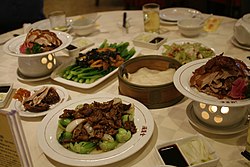
Xiaodong's food is primarily based around rice, vegetables and meats and is traditionally cooked so it possess a xianwei (鲜味) taste. Xiaodongese short grained rice is often steam-cooked and served with a variety of seafood alongside broth or soup. In most Xiaodongese dishes red yeast rice (红麴) is used to ensure a sweet taste and a reddish hue unique to Xiaodongese foods. Due to the countries coastal location, Xiaodongese dishes often also use fish-related ingredients and flavourings such as fish sauce and shrimp paste. Shark fins are also extensively used in Xiaodongese cuisine most notably in its shark fin soup, although recently there has been concerns that overfishing is resulting in a rapidly declining shark population. Xiaodongese food is usually eaten with chopsticks and spoons.
Xiaodongese cuisine can be divided into two groups. Furong (付容)cuisine from the northwest of Xiaodong uses sweet and spicy flavours with steaming and stir frying being commonly used with beef, duck, pork and slow-cooked soups being used more with less emphasis of sea food. In contrast Zhujian (住建)cuisine more widely eaten in the southeast mixes sweet and sour tastes and places much greater importance on seafood, fermented fish sauce and red yeast rice. Southern Xiaodong is also known internationally for dog meat. Immigration from Xiaodong to other parts of the world has resulted in Xiaodongese cuisine to be more widely eaten on an international scale.
Family and marriage
Xiaodongese views on family are heavily informed by the concept of filial piety. Filial piety is the term used to describe strains in Xiaodongese philosophy that emphasise the relationship between children and their parents with emphasis on how children should be respectful an obedient to children. Traditional Xiaodongese families are heavily patriarchal with the oldest male always being the head of the family and family inheritance (prior to 1940) being restricted to men. Prior to the 1970's due to demographic and economic strains it was traditional for three or four generations to live together in Xiaodong - however family planning in the 1970's led to a promotion of nuclear families.
Traditionally Xiaodongese marriages were complex affairs. A marriage would be arranged between two families by a matchmaker, with families expected to pay either a dowry or bride price (with the family of a higher rank paying less). Subsequently the spouse from the family of a higher rank would be expected to engage in polygyny or polyandry with the siblings of the lower ranking spouse, although men regardless of social rank were always allowed to keep concubines. Prior to marriage reform child marriage was not uncommon. Marriage reform in 1937 and 1952 saw the banning of concubinage, forced marriage and child marriage alongside severe restrictions on arranged marriages, dowries and bride prices. Economic pressures have also led to a decline in polygamous marriages, although such marriages are still existence in some parts of Xiaodong.
Film
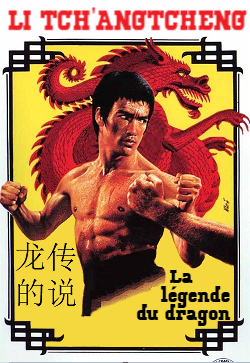
Cinema was introduced to Xiaodong in 1902, with the first Xiaodongese film being "The Travels of Chen Huqiang" which was made in 1903. Early Xiaodongese cinema was heavily influenced and inspired by Xiaodongese opera which was then the dominant form of entertainment in Xiaodong. Film making in Xiaodong at the time was centred in Baiqiao and Kuoqing.
The first "talkies" in Xiaodong was made in 1928 during the Senrian-Xiaodongese War, and were primarily war and propaganda films intended to rally support for the war effort. The most famous was Leaving Home for Kitasuu which pioneered cinematic technique in Xiaodong in the realms of editing, lighting and sound design. Xiaodongese cinema suffered a decline in the early 1930's due to the after effects of the Senrian-Xiaodongese War and Corrective Revolution, but by the late 1930's and early 1940's with a relaxing of political repression Xiaodongese cinema entered its "Golden Age" of . Led by directors such as the Kang brothers and Guo Wenzhan the Golden Age saw films move beyond propaganda and embrace more realism and innovative cinematic techniques, with the most acclaimed films being Solitary Spring, Death on the East Sea River and Ms Jiang's Secret. During the 1950's the largest film studio - Jinhua Films - grew to have a virtual monopoly over the market leading to filmmakers to lose much of the innovation of the 1940's.
The late 1960's and early 1970's however saw the rise of low budget martial arts films explode in popularity, with the films of Li Changzhen (such as Legend of the Dragon) being especially successful. Between 1967-1975 Xiaodongese cinema entered a "second golden age" as martial arts films and romantic dramas became very popular, with independent studios driving both trends. The 1960's and 1970's golden age saw a tendenacy towards action and melodrama. The imposition of strict censorship in 1975 ended the second golden age, as martial arts films in particular coming under fire from authorities. The late 1970's to early 1980's saw Xiaodongese cinema churn out regular films but ones that were commonly seen as creatively stagnant and corporate in nature.
The social and economic changes of the 1980's led to another resurgence in Xiaodongese cinema, but unlike the melodrama of earlier years there was more emphasis towards neo-realism. Nevertheless, it was not until the release of Golden Rain in 2006 - a romantic drama film - that Xiaodongese cinema has seen a renaissance in recent years. Modern Xiaodongese cinema is often split between dramas and romances and action films, with a focus on realist acting and an increasing prevalence of both independent cinema and higher budget productions.
Holidays
| Holiday | Xiaodongese Fuhao |
Date | Description |
|---|---|---|---|
| Spring Festival | 春节 Chūnjié |
Turn of the traditional lunisolar Xiaodongese calender | Celebrates the first day of every year in the Xiaodongese calender. |
| Lantern Festival | 元宵节 Yuánxiāojié |
15th day of the 1st month in the Xiaodongese calender | Celebrates the last day of the Spring Festival celebrations. |
| Restoration Day | 再生节 Zàishēngjié |
14th February | Celebrates the Baiqiao Revolution and the Heavenly Xiaodongese Empire. |
| Qingming Festival | 清明节 Qīngmíngjié |
15th day from the Spring Equinox | Visit, clean and honour ancestors. |
| Duanwu Festival | 端午节 Duānwǔjié |
5th day of the 5th lunar month | Commemorates fealty and filial piety, traditionally celebrated with dragon boat racing. |
| Ghost Festival | 盂兰盆 Yúlánpén |
5th night of the 7th lunar month | Make offerings to the dead and ancestors to ward them off from troubling the living. |
| National Day | 国庆节 Guóqìngjié |
20th-22th September | Celebrates the Great Revolution to Correct Xiaodong and the founding of the Auspicious Republic of Xiaodong. |
| Mid-Autumn Festival | 中秋节 Zhōngqiūjié |
15th day of the 8th lunar month | Celebrates the end of the autumn harvest. |
Literature
Xiaodongese literary tradition stretches back to the development of the Xiaodongese script around 2000BCE. The classical Xiaodongese canon is rooted in military strategy, geography, astrology and mythology. The Nine Texts (九个文本) - as series of philosophical, historical and literary texts integral to Taojiao - continue to be taught in the state-sponsored examinations for civil service. Other seminal Xiaodongese classics include Sijiu (a collection of Xiaodongese folklore) Journey to the Gods and The Blue Chamber.
Music
Xiaodong's music is diverse, having a mix of traditional and more modern influences. Traditionally, nanyin (南音) music has been dominant in Xiaodong, having light foreign influences due to Xiaodong's coastal location and was mainly preformed by amateur quguan groups who were often based around local temples. There are two main types of nanyin music - zhi (指) and qu (曲). Zhi is exclusively instrumental, being performed using gongche notation and can be up to thirty minutes in length (or divided into five pieces, or dei) whereas qu uses vocals and is far less conservative then zhi, having a much wider range of pieces. Nanyin is performed with a pipa, sanxian, xiao and erxian with singers using wooden flappers. In a "ten sounds" performance a suona and dizi is used.
Following the Baiqiao Revolution Xiaodongese music began to resemble that of music in Euclea, with use of orchestrates especially wind and string instruments, which were combined with traditional Xiaodongese instruments. Xiaodongese musicians would travel to western countries such as Gaullica, Werania and Etruria
bringing over western music and instruments which coincided with a general period of westernisation in Xiaodongese culture. Symphony orchestras became popular in the 1880's-1890's amongst the elite in Xiaodong. During the 1910's and early 1920's more modern forms of music became popular in Xiaodong, with Rongzhuo being known within the country for its vibrant jazz scene. Many musicians during the 1910's incorporated jazz elements in traditional music. When Xiaodongese society became more militarised during the 1920-30's brass instruments were used more as music reflected nationalist themes whilst jazz and popular music were shut down by the government.
Following the Corrective Revolution, the government promoted traditional nanyin music, but during the 1940's lifted restrictions on jazz and popular music, which underwent a revival in the 1950's-1960's. During the 1970's, music began to be put under stricter censorship with two forms of music being dominant - political music, which was promoted by the government and a modern form of Xiaodongese folk music. This "new folk" music often fused traditional Xiaodongese folk song melodies with a mix of traditional Xiaodongese and western instrumentation, and often took the form of ballads. The 1960's-1970's saw the introduction of electric guitars and electronic organs/synthesisers to be used in Xiadongese music. During the mid 1970's-1980's, Liu Zhou was recognised as the most pre-eminent Xiaodongese pop singer and became popular across Coius.
During the 1980's rock music became popular amongst the youth and was widely played and distributed on the black market, despite being frowned upon by the authorities. Nevertheless in 1984 the ban on rock music was successfully repealed and rock music in Xiaodong became extremely popular during the 1990's, especially heavy metal and after 1998 thrash metal. Punk music was also popular in the 1990's, with the first punk bands making a breakout in 1995.
Since the late 1990's the dominant popular music in Xiaodong has been "Xiao-pop", often similar to its western counterparts in its style, with its growth helped by its use in television, films and other elements of popular culture. Since the 1980's, "pop idols" have gained fame and popularity in Xiaodong.
Media
Xiaodong has several media sources with there being a semi-free press. The main daily newspaper in Xiaodong is the Xiaodong Observer (晓东观察报; Xiǎodōng guānchá bào) which is part of the state-owned Xiaodongese Broadcasting Network, and is considered to be pro-government and conservative. The other newspapers include the East Sea Daily (东海日報; Dōng Hǎi Rìbào), a privately owned paper that is more sensationalist and tabloid in nature than the Xiaodong Observer being known for its more populist and heavily nationalist editorials, the Xiaodong Evening Post (晓东晚報; Xiǎodōng Wǎnbào), a liberal centre-left paper that is anti-government and has a high circulation especially in southern Xiaodong, The Sun (太阳报; Tàiyáng Bào) an economic liberal paper focused on economic and business news and the Global Review (全球考察; Quánqiú Kǎochá) which was previously a pro-opposition paper but since 2014 has been owned by the same company that owns East Sea Daily, now re-orientated to be more right-wing populist and nationalist albeit more upmarket than the East Sea Daily.
Society
- Main page - Hokka system
Traditionally Xiaodongese society is highly stratified under the Hokka (種姓) system. The Hokka system, which forms an essential part of Taojiao teachings, stipulates that Xiaodongese society is roughly divided into several social classes, commonly seen as large families. At the top traditionally sit the shiren(士人; scholars and knights) and the guizu (贵族; nobles and artisans), followed by nongmin (农民; farm people) and finally shāng (商; understood to be traders). Prior to the 1960's a fifth class, didengren (低等人; roughly translates to subhuman) existed and was often used as a racial classification as well as a social one. Each social class saw themselves as an extended family, to the extent where family names are restricted to the social class one occupies. Each social class is expected to take a collectivist mindset that mandates that they help each other, whilst lower social classes are expected to support their superiors to retain a stable society. Within each social class gender parity is emphasised, although de facto sexism has always existed in Xiaodong.
The Hokka system was seriously undermined by Toki rule, which saw Senrians become a distinct dominant minority. Despite the industrialisation that took place after the Baiqiao Revolution, with which saw the rise of a new social class of industrial workers often straddling between the shāng and nongmin classes, the Baiqiao Revolution nevertheless saw the system greatly strengthened as the Hokka system was reinterpreted as integral to Xiaodongese culture. During the 1920-30's the system became more firmly entrenched as well as leading to discrimination to dramatically increase towards the didengren class in particular. Following the Corrective Revolution the Hokka system was formally abolished, with the influence of the guizu class declining in favour of the Tuhao (土豪; new money) class, which consists of a mix of shāng and shiren. Nevertheless the divides within Xiaodongese society and influence of the Hokka system remain albeit in a modified form with the traditional classes breaking down in favour of the Xin Hokka system which consists of the Tuhao, the zhongjian ren (中间人; middle people) and the buyi (布衣; commoners).
Sports
Xiaodong has maintained strong sporting traditions since the advent of dragon boat racing around 2,500 years ago. Currently the most popular sports in Xiaodong are martial arts followed by football and basketball. Badminton, ping pong, and swimming have also recently gained popularity in Xiaodong. Traditionally archery, horse racing, cuju and wrestling were the most practiced sports in Xiaodong. In modern Xiaodong, most citizens practice a form of tai chi or qigong.
Xiaodong has long been associated with martial arts, often grouped under the umbrella term Quanfa (拳法). Xiaodongese martial arts are divided into various sects (派; pài) with martial arts often being rooted and inspired by Xiaodongese philosophy. Xiaodongese martial arts generally place emphasis on acrobatics and kicking (such as high kick and flying kicks). Xiaodongese martial arts are encouraged today by all schools with thousands of training facilities and classes around the country.
Cuju was traditionally a popular sport in Xiaodong being the first mass sport in the country around the late Xiang dynasty. It continued to be practiced widely until the mid 1940's when football started to take its place, thanks partly to the advocacy the National Federation for Football (formed in 1918) gave to the sport. Currently football is by far the most popular sport in Xiaodong being divided into five leagues - the Premier league, the first league,
the second league, the third league, and the local leagues. The Premier league consists of the 16 best football clubs in Xiaodong, whilst the first league deals with the 25 next best teams. The second league also has 25 teams as does the third league. Teams advance to higher leagues if they are among the top four in the league at the end of the football season, whilst those at the bottom 4 places in the league are relegated to a lower league.
Other popular sports in Xiaodong include basketball which was introduced to Xiaodong in the 1960's and is managed by the National Basketball League, ping pong which is the largest amateur sport with Xiaodong producing famous ping pong players such as Li Jiangguo and badminton. The oldest sport in Xiaodong, dragon boat racing, is also still practiced with many watching the annual duanwu festival.
Television
Television is popular in Xiaodong, with the main three television stations - the state-owned Xiaodongese Broadcasting Network (XBN), the free to view Rongzhuo Broadcasting Corporation and the largest cable TV station, TV Xiaodong. Xiaodong has a wide range of television programming including children's television, animation, documentaries, music television, news, sport and movies. Television dramas are extremely popular in Xiaodong, especially those set in historical periods and fantasy romance.
There had been almost no television in Xiaodong prior to 1947 when the first Xuling Television set was created. There were only three television stations - the Central Xiaodong Television 1 (ZDX1), the Central Xiaodong Television 2 (ZDX2) and Xiaodongese Sports (XT). ZDX1 was exclusively broadcast in the Xiaodongese language and aired a broad variety of programming from children television shows, the news and adult dramas whilst the ZXD2 aired similar programming, albeit often programs with lower ratings. XT meanwhile primarily focused on sports programming.
Initially programming was primarily political, mostly taking the form of propaganda films praising the ruling regime - even in the nominally sports centred XT more time was dedicated to political programming. In 1949 the first children's programme - Little Xie Yuanhong - was created, and in 1950 television dramas and comedies were created. Programmes rarely exceeded 20 minutes, and typically television shows lasted for 12 episodes a series. All shows were under strict censorship laws, and so often avoided certain subjects such as politics (or only showed the positive aspects of Xiaodongese history) or religion. Television remained formulaic with most shows being contemporary in nature until the early 1960's, when the first science fiction and historical programmes started to be broadcast alongside documentaries. The XT channel was popular amongst Xiaodongese being less politicised and respected as a reliable and (comparably) uncensored channel for sporting interests. There was an upsurge in the popularity of television in the 1960's and 1970's as programming became more diverse. Initially people appearing on television were also under strict rules. Men were prohibited from wearing beards, and there were a limited number of clothes and haircuts non-political figures could wear on television. Make-up was strictly prohibited. These controls were relaxed during the 1980's, when the first colour televisions were introduced.
in 1985 the ZDX2 and XT were privatised and the state began to allow private networks to be set up. ZDX1 was renamed as the Xiaodongese Broadcasting Network (XBN) as private TV became popular. During the 1970's Xiaodongese drama shows began to become the dominant genre and during the 1990's there was a notable increase in production values and script quality.
Theatre and Dance
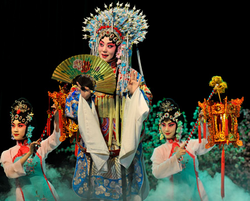
Traditional Xiaodongese opera has developed over centuries to combine music, vocal performance, mime, dance, and acrobatics within it. The earliest Xiaodongese theatrical performances during the early Xiang dynasty were based on "mask performance" (面具表演; miànjù biǎoyǎn) which were silent mime performances that were played in the royal court. Travelling performers would often act plays in villages that were based in folklore with dialogue spoken in verse, but these shows were for a long time seen as vulgar.
During the mid-Xiang dynasty zaju (雜劇) performances became popular, with the roles within performances started to be separated between the sheng (生; male characters) dan (旦; female characters) jing (净; painted face male often but not always in a supporting role) and chou (丑; male clown and always a minor or supporting character). By the Tao dynasty elements of acrobatics and dialogue began to be common in Xiaodongese theatre. Increasingly musical elements and singing was added to performances with the main instruments being used being jinghu's and yueqin's.
Under the Toki dynasty elements of kabuki influenced Xiaodongese theatre, in particular a use of makeup over traditional masks and performances that often lasted full days. The Heavenly Xiaodongese Empire saw the height of Xiaodongese opera which began to exhibit plays based in history, mythology and contemporary life. Xiaodongese opera continued to be popular until the 1960's when the popularity of films started to surpass it. Since then there has been moves to change Xiaodongese opera (such as importing western theatrical techniques, shortening the length of plays and putting greater focus on contemporary plays) to mixed success. Template:XiaodongTopics



